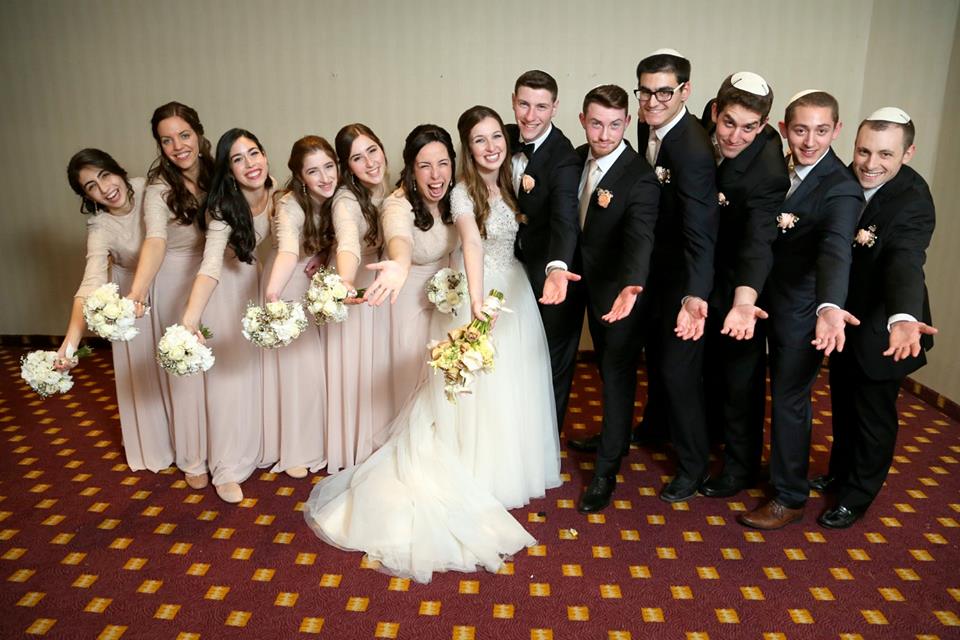Dress
A big part of daily life for an Orthodox Jew is comprised in how you dress. Jewish law and guidelines shape your life from the most private to the most public ways in which you live, and dress is no different. From head to toe, life as an Orthodox Jew shapes what you wear. Some of this is obvious to anyone looking in. Have you ever seen someone wearing a black hat or kippah (yamulka/skull cap)? This is one of the most blatant “Yo, I’m Jewish” things you can wear, right? I bet you never thought, though, that the specific design of hat or kippah that they’re wearing, or even if their socks are tucked in or out, had anything to do with their religious philosophy. Well, think again.
I’ve mentioned that Orthodox Judaism is incredibly diverse. Dress is a perfect example of this, and while I wish I could give you a whole lesson in what each person’s hat or robe or socks mean, I can’t. I don’t know a ton about it myself, beyond that it signifies things like what community their family came from or what rabbi they follow, etc., but also, if you come away from this website being like “Wow, I wonder what that guy’s socks mean,” you’ll have missed the bigger picture. Spoilers: my husband’s socks don’t mean anything, beyond that he tries to make them match his outfit. Instead, I’ll give you a bigger picture overview of the whole “Dress” thing when it comes to Orthodox Judaism.
First, where does it all come from? There’s a concept of “Tzniut” (pronounced “snee-oot”). It means modesty. It doesn’t only apply to how you dress, but this is one of its biggest applications. Men and women are both expected to dress modestly. Different communities and rabbis have different ideas about what this should look like.
Here’s a broad idea, divided by gender. I’ll start with women (skirts, shirts, and hair covering) because I am one! For men (yamulkes, black hats, white fringes that come out from under their shirts, and long curly side burns), scroll down further.
 (Photo taken from my sister’s wedding)
(Photo taken from my sister’s wedding)
Women
Skirts: Almost all Orthodox women will only wear “long” skirts (as opposed to pants. The exception to this rule is at the most liberal end of the spectrum, you’ll find some Orthodox women who wear pants, often that are not form-fitting, but this is a small minority). I’m definitely at the liberal end of the Orthodox spectrum, and I only wear skirts. How long your skirt needs to be depends on where you fall on the Orthodox spectrum, basically. I wear knee-length skirts (my closet is pencil skirt-city). Some wear skirts to the knee, some wear skirts just below the knee, some wear skirts to their ankles, some won’t wear form-fitting skirts. It varies by community. Modern Orthodox Jewish women would be in the “knee-length” neighborhood.
Shirts: While you won’t be seeing any cleavage, how much your shirt needs to cover also really varies by community. In terms of neckline, it more or less ranges anywhere from not showing cleavage to a few fingers below your collar bone to covering your collar bone. As for sleeves, everyone would cover their shoulders, many would cover their elbows, and some only wear tops that go to their wrists. Form-fitting vs. not form-fitting, again, it depends on the community. In some communities, color matters a lot. Many women won’t wear red because it’s associated with seduction. Some communities won’t wear colors that stand out at all (think black and white and dull colors). Personally, I wear any and all colors, and short sleeves with a below-the-collar-bone neckline, which puts me at the most liberal end of the spectrum.
Hair Covering: Jewish law dictates that married Jewish women need to cover their hair (Anytime that I type “Jewish law dictates”, you should be VERY skeptical and ask “Is it that simple?” to which the answer is a resounding “NO!”). There’s a big Jewish legal debate, especially in the Modern Orthodox Jewish community, over whether Jewish women need to cover their head, their hair, and whether it’s binding because it’s a law-law or a community standard. Take away: it’s complicated.
The idea of hair covering derives from a single story in the Torah about the “Sotah,” in which a reference is made to removing a woman’s hair covering if she was strongly suspected of infidelity. The rabbis, then, of course, were like “hair covering?? Oh, that must mean that married women are supposed to cover their hair.” Judaism hangs on every single letter in the Torah, let alone word or sentence, so this is a pretty typical way that things get derived. Married women, then, would only show their hair to their husband, family, and other women depending on how stringent you are.
With the caveat that some Modern Orthodox married ladies don’t cover their hair at all or maybe wear a thick headband, here’s a little taste of how hair covering works. The vast majority of Orthodox Jewish married women do cover their hair. Some won’t show a single strand, and some will show a little bit (an inch or two); just like with everything else, it depends on the community and what rabbi you follow.
There are a few methods that women use to cover their hair. Some wear a “mitpachat” or “tichel” (a pretty scarf wrapped in a cool, pretty way). A friend of a friend has a whole website selling these if you want to get an idea of what they look like. Some women wear a hat. A really common way to cover your hair is with a wig or “sheitel” (which is the Yiddish word). If you’ve ever seen religious Orthodox Jewish women, especially the ones wearing ankle-length skirts with husbands who have black hats, you probably didn’t realize, but I can essentially guarantee you that they were wearing wigs.
Fun fact about wigs (and this is always the *gasp* moment from my friends): I wea r one! A lot of my secular friends don’t realize that I cover my hair (although now that I’m publicly explaining it here, I imagine that may change…), but yeah, I do. Here’s a picture of me… any pictures taken of me since the day after my wedding have me wearing a sheitel, not showing my real hair. Mine begins under my headband, so the hairline is my real hair but the rest is not. I personally feel that wearing a wig is the best way for me to fulfill this obligation while still looking and fitting into the modern world around me. I’m sure none of you ever would have known just seeing my picture or even if you met me. You really can’t tell, until you’re super in tune with what to look for.
r one! A lot of my secular friends don’t realize that I cover my hair (although now that I’m publicly explaining it here, I imagine that may change…), but yeah, I do. Here’s a picture of me… any pictures taken of me since the day after my wedding have me wearing a sheitel, not showing my real hair. Mine begins under my headband, so the hairline is my real hair but the rest is not. I personally feel that wearing a wig is the best way for me to fulfill this obligation while still looking and fitting into the modern world around me. I’m sure none of you ever would have known just seeing my picture or even if you met me. You really can’t tell, until you’re super in tune with what to look for.
Also, if you’re sitting here thinking “Wait a minute, covering hair with hair… isn’t that cheating?”, know that you would not be the first person to ask that question. It’s something I grappled with for months. The best way to explain it, in my opinion, is that it perfectly embodies the idea that Judaism is a religion of laws. You’re either following a law or you’re not. If a speed limit is 45 MPH, driving 46 is technically breaking the law and driving 44 is not. You wouldn’t say “Well, I understand the spirit of the law is telling me to slow down, and therefore, I will choose to drive 30.” You can drive 44 and it’s perfectly fine. So too with wearing a wig. You’re covering your hair or you’re not.
Men
Kippah/Hat: For a man, what you have sitting atop your head signifies a lot. Among Orthodox Jewish men, every guy would have something, but what he wears would vary. Avi, my incredible husband, wears a kippah (which is the Hebrew word for skull cap, “yamulke” means the same thing in Yiddish) every day. You don’t wear it to sleep or in the shower or anything, but besides that, you’re basically wearing it all the time. The material that your kippah is made from signifies something political.
Avi wears a “knitted” kippah, as opposed to a velvet one. This means that he’s Modern Orthodox, or in Israel, it means that he’s a Zionist (supports the idea of a Jewish state in the land of Israel… this is SUPER complex and nuanced and not something that I really have room to get into here). Basically, it means he is NOT ultra-Orthodox or Hareidi. Below is a picture of Avi (with a good view of his kippah) with one of our beloved Rabbis, who, as you can see, is wearing a black hat. That signifies that he’s not “Modern Orthodox,” but rather, at a different place on the spectrum from where Avi would define himself. A lot of this stuff is very individualized and depends on the country and community that you live in. This rabbi, for example, is very much Zionist, but his philosophy or interpretation of Jewish law might fall somewhat to the right of Avi. That said, there’s a lot of overlap, it can be quite personal, and I feel like any more generalizations I type will just guarantee offending one person or another. Take away: hat means something.
Of those men who wear black hats, the specific design of hat that you wear assigns you to one community or another. If you’ve ever seen a furry cylindrical hat, it’s called a “shtreimel.” What community you come from and where your family came from would determine if this is the kind of hat that you wear. It’s made of fox fur, and it’s very pricey.
Tzitzit: Have you ever seen a man with some sort of white fringey things hanging out of his shirt? This is called tzitzit. All Orthodox Jewish men wear them, although some men might tuck them into their pants so that you don’t see them. They wear it as an undershirt. It comes straight from the Torah in the book of Numbers, where it says “Speak to the children of Israel and say to them: They shall make for themselves fringes on the corners of their garments… And this shall be tzitzit for you, and when you see it, you will remember all the commandments of G‑d, and perform them”. Welp, there are the fringes on the corners of their garments! Pretty straight forward.
Payis/Payot: This one I get questions about all the time. Have you ever seen religious Jewish men with long curls right in front of their ears? Yeah, those are called “payis” or “payot” depending on your accent and where your family came from. It means the same thing. In Leviticus is says something about “not rounding off the corners of your head.” Thus, the payis was born. Some people curl theirs. Some people, like my husband, just keep sideburns of a certain length to fulfill this commandment.
